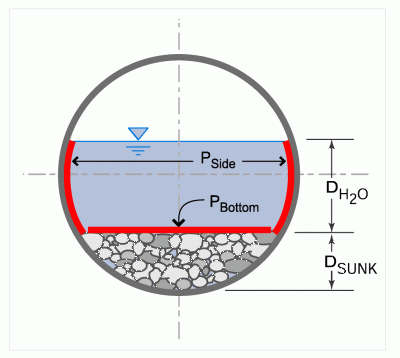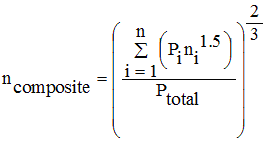Composite Roughness Calculations |
When a culvert or channel cross section has areas of different roughness, a composite Manning’s roughness coefficient must be calculated. The composite roughness is weighted based on the wetted perimeters associated with the different roughness segments. Therefore, the composite roughness changes with changes in water surface elevation. FishXing uses composite roughness for the tailwater cross section calculations and for culverts with composite materials (such as an embedded culvert).
Composite Roughness for Culverts
FishXing allows you to input a roughness coefficient for the bottom of the culvert different than the roughness for the rest of the culvert. This applies to open bottom culverts and closed bottom culverts that are embedded. In these situations, FishXing assumes the bottom segment to be horizontal.

For culverts, FishXing uses the following form of the Horton-Einstein equation:

Where:
ncomposite = Mannings roughness coefficient for multiple materials
Pside = Perimeter of side material
nculvert = Mannings roughness coefficient of culvert material
Pbottom = Perimeter of bottom material
nbottom = Mannings roughness coefficient of bottom material
Composite Roughness for Tailwater Cross Section
When more than one roughness value is entered for the tailwater cross section, FishXing uses the Horton-Einstein equation to compute a composite roughness:

Where:
ncomposite = Mannings roughness coefficient for multiple materials
P = Perimeter of material
i = subsection of crossing
If a Darcy-Weisbach friction factor or Chezy coefficient is used instead of Manning’s n, FishXing converts the alternative roughness coefficient into an equivalent Manning’s n to calculate a composite roughness.